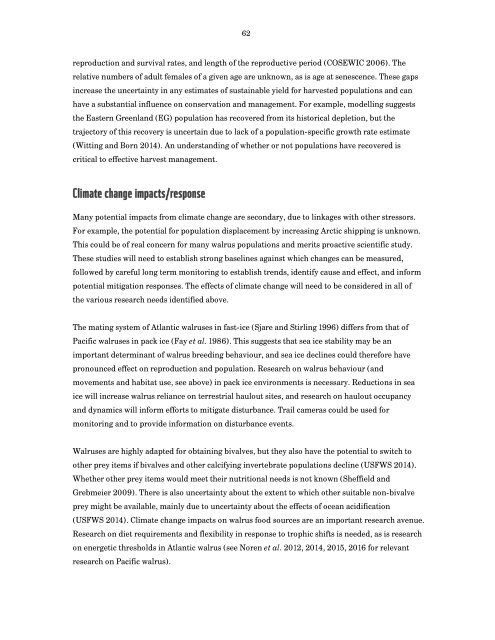The State of Circumpolar Walrus Populations
walrusreport
walrusreport
Create successful ePaper yourself
Turn your PDF publications into a flip-book with our unique Google optimized e-Paper software.
62<br />
reproduction and survival rates, and length <strong>of</strong> the reproductive period (COSEWIC 2006). <strong>The</strong><br />
relative numbers <strong>of</strong> adult females <strong>of</strong> a given age are unknown, as is age at senescence. <strong>The</strong>se gaps<br />
increase the uncertainty in any estimates <strong>of</strong> sustainable yield for harvested populations and can<br />
have a substantial influence on conservation and management. For example, modelling suggests<br />
the Eastern Greenland (EG) population has recovered from its historical depletion, but the<br />
trajectory <strong>of</strong> this recovery is uncertain due to lack <strong>of</strong> a population-specific growth rate estimate<br />
(Witting and Born 2014). An understanding <strong>of</strong> whether or not populations have recovered is<br />
critical to effective harvest management.<br />
Climate change impacts/response<br />
Many potential impacts from climate change are secondary, due to linkages with other stressors.<br />
For example, the potential for population displacement by increasing Arctic shipping is unknown.<br />
This could be <strong>of</strong> real concern for many walrus populations and merits proactive scientific study.<br />
<strong>The</strong>se studies will need to establish strong baselines against which changes can be measured,<br />
followed by careful long term monitoring to establish trends, identify cause and effect, and inform<br />
potential mitigation responses. <strong>The</strong> effects <strong>of</strong> climate change will need to be considered in all <strong>of</strong><br />
the various research needs identified above.<br />
<strong>The</strong> mating system <strong>of</strong> Atlantic walruses in fast-ice (Sjare and Stirling 1996) differs from that <strong>of</strong><br />
Pacific walruses in pack ice (Fay et al. 1986). This suggests that sea ice stability may be an<br />
important determinant <strong>of</strong> walrus breeding behaviour, and sea ice declines could therefore have<br />
pronounced effect on reproduction and population. Research on walrus behaviour (and<br />
movements and habitat use, see above) in pack ice environments is necessary. Reductions in sea<br />
ice will increase walrus reliance on terrestrial haulout sites, and research on haulout occupancy<br />
and dynamics will inform efforts to mitigate disturbance. Trail cameras could be used for<br />
monitoring and to provide information on disturbance events.<br />
<strong>Walrus</strong>es are highly adapted for obtaining bivalves, but they also have the potential to switch to<br />
other prey items if bivalves and other calcifying invertebrate populations decline (USFWS 2014).<br />
Whether other prey items would meet their nutritional needs is not known (Sheffield and<br />
Grebmeier 2009). <strong>The</strong>re is also uncertainty about the extent to which other suitable non-bivalve<br />
prey might be available, mainly due to uncertainty about the effects <strong>of</strong> ocean acidification<br />
(USFWS 2014). Climate change impacts on walrus food sources are an important research avenue.<br />
Research on diet requirements and flexibility in response to trophic shifts is needed, as is research<br />
on energetic thresholds in Atlantic walrus (see Noren et al. 2012, 2014, 2015, 2016 for relevant<br />
research on Pacific walrus).


